
I had been in Japan studying pottery for almost two years when I came to Korea for the first time in 1979. With all due respect and much gratitude, in Japan, I was never going to feel quite at home or at ease. When I traveled to Korea for the first time, I felt immediately comfortable and full of curiosity about the culture. It was my early exposure to Korean Minwha, which I have collected seriously since that first trip that struck such a resonant chord in me. Over time, I have developed deep respect and empathy for Korean people and their culture. So immediately after starting my career as a teacher I began inviting Korean artists to work at school and enthusiastically welcomed students to come and study at the university in Long Beach. I am currently in my 27th year of teaching and I am so proud to say that collectively all of the Korean artists and students that have worked in our studios have in my opinion helped shape and create the identity of our program in no small way. So why have so many of the diversely talented Korean artists done so well at Long Beach in this period of time? Here are several thoughts as to why.
My first trip to Seoul in 1979 introduced me to a country that was vastly different than Seoul is today. The modernisation of Korea has been rapid and there are many complex explanations for that, however, I will oversimplify it by saying that basically It is the spirit of hard work and sacrifice that has built this modern chapter of Korean history. It is exactly that spirit which many Korean students bring with them to the states.
The four Korean artists that I will speak about are the children of the generation that was responsible for the post-war growth here. Like their parents, they all work as though they have something to prove. At Long Beach, we teach students from all over the world and specifically from every major culture in Asia. As a group, it is not easy to compete with how hard the Korean’s work. So, generally, young Korean students arrive with good artistic instincts and well-developed skill sets. They also carry a distinct artistic heritage with them whether they know it or not and a strong sense of cultural identity. Altogether, it seems to be a great recipe for success.
I started teaching in Long Beach in 1988 and I have been blessed with a steady stream of talented, artistically ambitious Koreans who were either invited to come work, enrolled as students or were sent to us by one of the Korean professors whom I am in contact with. I chose these four artists from a list of many based on artistic accomplishment and generally some but not all of the following qualifiers: All were born in Korea and educated both at home and in the United States, all have been here making and exhibiting art and or teaching at universities for approximately ten years and are participants in the artistic discourse in contemporary American ceramic art at some level through their teaching and or creative work.
Sun Koo Yuh

Sun Koo Yuh received his BFA from Hong Ik University in 1988 and was a Post Baccalaureate student at Long Beach State for three years in the mid-1990s. He went on to receive an MFA from Alfred University in New York 1997 after which we hired him to teach for us for several years. He is currently a Professor of Art at the University of Georgia, Athens in the southern United States. He has exhibited his ceramic sculpture all over the world and has won numerous awards, including the Grand Prize at the 2nd World Ceramic Biennale International Competition, Icheon. His ceramic sculpture is in many important museum permanent collections.
Yuh is an artist who was born in Seoul and raised in a Buddhist/Confucian culture, however, he grew up in a Christian household, so he knows complexity. His art is a map that guides us through the sentiments and symbols of all three belief systems. He has been in the US now for over twenty-five years and in that time has learned to graft what he needs from each culture into an integrated artistic expression.
He moves fluidly between the vivid differences in language, history, values and assumptions of two very powerful cultures. It is an East / West split.
Because of the dense number of characters and socio-historical complexity of many of his works, they broadcast multiple messages to be interpreted by the viewer. In one work alone we may find moments of beauty, horror, tenderness, humour and the absurd. His figurative sculpture is not made up of portraits of known individuals. Rather it is a compendium of archetypes.
The sculpture is made quickly and comfortably as though Sun Koo is in casual conversation with old friends as he works.
As Yuh’s talent and understanding of his work grew, he was inspired by Korean Minhwa painting as a way to introduce more colour and humour in his art. After many years, Yuh has become a masterful painter with glaze. No easy task. Large works can be painted with as many as forty different hi-temperature glazes. He understands the chemistry of glaze colour and takes full advantage of heat, material interaction, gravity and flow to create new combinations of layered ceramic colours at hi-temperature. His approach is absolutely unique and I cannot think of anyone in contemporary ceramic art who works large and uses such a vibrant palette of colour at high temperatures as does he. Many of Sun Koo’s works are destroyed by his chosen process. The risks are great but so are the rewards.

Sun Koo Yuh working on a large porcelain tile while in China in preparation for his exhibition at Gimhae Clay Arch
Making this work probably has as much to do with problem-solving, engineering and a test of his will as it does, story-telling and the pleasure of creating. Yuh has invented not only how it should look, but also how it needs to be built in order to survive. One can see that making ceramic art for Yuh is a test of the limits of the material and more importantly his ability and endurance. He pays a price to make this work. There is no artistic precedence for this kind of ceramic art that I know of, no book on how to make it. This art is an original expression of his integrity, vision for his work and artistic intelligence. He has invented numerous unique systems for building, firing and moving very large complex and ultimately fragile ceramic sculptures.

One of at least three major exhibition spaces full of Yuh’s work at Gimhea Clay Arch. The totem on the far left is one of his first large-scale pieces and it was created at the studios of Long Beach State.
An incomplete inventory of several of his works pictured here would include the following: tiger, duck, human skull, demons, saints, a mythological sea creature, assorted good and bad men and women, a howling dog, a monkey, flowers in bud and blossom, a priest, a king, a fighter and more. These totems are a sculptural repository and the artist’s reconciliation of a life lived between cultures. I’ll continue: mythological guardian animals, mothers, children, fathers, aunts and uncles, strange birds, assorted domestic, farm and wild animals…. and on it goes. Perhaps the more compelling question would be, what exactly has been left out? There are many actors in these dramas and they are not randomly chosen… but part of an expanding cosmology of characters orchestrated to appear and reappear in these stacked histories. Yuh is an artist in his prime who is as artistically ambitious as anyone in the field of ceramic art. It is becoming increasingly difficult for him to find institutions that have the resources that allow him to accomplish his most ambitious work.
JAE WON LEE
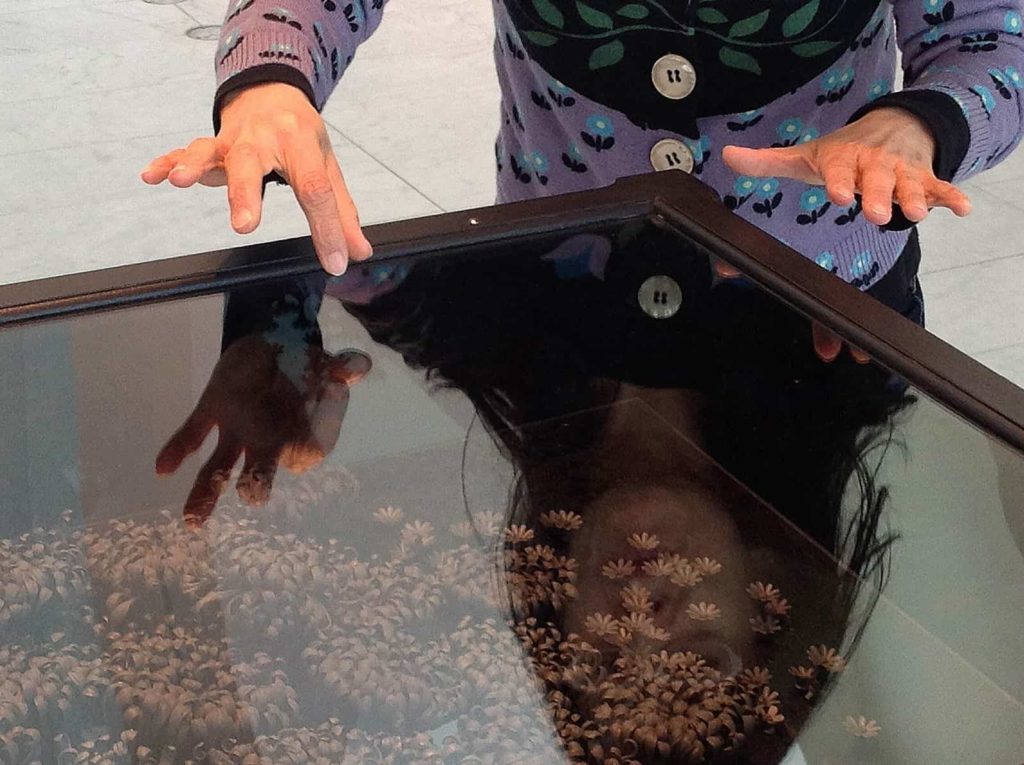
Jae Won Lee was born in Seoul and sent to the United States by her parents to complete her university education. She graduated from CSULB in 1991 with a BFA degree in Sculpture and from Alfred University in 1995 with her Master of Fine Arts degree. Professor Lee was also hired to teach for us after graduating and currently teaches Art at Michigan State University. She has lived and worked in America for over twenty years.
She told me that she no longer feels naturally at home in either the east or west. Some of the earliest artistic work that she exhibited were these minimalistic, intimate, simple geometric forms with colour and Asian inspired floral patterns.
She occasionally describes them as like books, sometimes open, sometimes closed. She also told me that once in a while when making these box forms she would think about dosirak, an important childhood memory for her. She described dosirak to me as a direct expression of daily love from a mother to a child in Korea and this artistic abstraction of that idea in turn, is a way for her to express an unspoken form of appreciation and love to her mother.

The floral patterns in this body of work are painstakingly inlaid in the surface of the porcelain as homage to the great inlaid pottery of the Goryeo and Joeson Dynasties. The patterns themselves are a reflection of childhood memories of having watched her grandmother practice traditional embroidery. At the time, she thought that the needles her grandmother used were magic. So in fact, the patterns were created with needles rather than a more traditional, easier to use a ceramic tool. I believe the work was inspired by her childhood in Korea, but also by Post-Minimalist sculpture being created in Los Angeles during her time there. It established an artistic expression for Lee that was simultaneously culturally and personally symbolic.
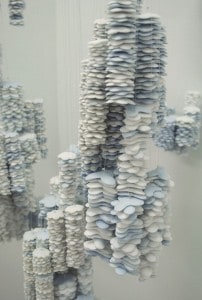 In approximately the next ten years, she worked on multiple projects. Frail Hope Internal Distance was her main undertaking. The series to date has twelve separate but related works. Sacrifice is an important value in the Korean experience and psyche. For Lee, to make art became increasingly about engaging projects that required her to bring the proper amount of energy and focus to the making of many thousands of repetitive small objects alone, by hand.
In approximately the next ten years, she worked on multiple projects. Frail Hope Internal Distance was her main undertaking. The series to date has twelve separate but related works. Sacrifice is an important value in the Korean experience and psyche. For Lee, to make art became increasingly about engaging projects that required her to bring the proper amount of energy and focus to the making of many thousands of repetitive small objects alone, by hand.
Her chosen colour scheme in much of the repetitive porcelain work is white with multiple shades of blue which among other things aligns itself with the great Korean and pan-Asian traditions of blue and white porcelain works.
Lee has created a lot of her art while traveling to work in other studios around the world. She has completed artist residencies in China, Taiwan, Korea, Denmark, India, England, the Netherlands as well as several in the U.S. She trades the comfort of home for a sense of displacement and solitude. It gives her the opportunity to meet artists from around the world, test new ceramic materials and further define her artistic expression and cultural identity against the backdrop of different cultural circumstances. The displacement makes her by necessity more creative. Increasingly, Lee says there is in the work a quiet longing and perhaps poetic search for a sense of true home—a home she may now never have.
This work is in some way an homage to a segment of the great Goryeo and Joseon dynasty porcelains. Lee uses the language of ceramic colour as a culturally identifiable marker. Koreans understand these colours in a very specific way. Perhaps to few other cultures is white, in all of its permutations, as important a colour and idea as it is to the Koreans.
Myungjin Kim
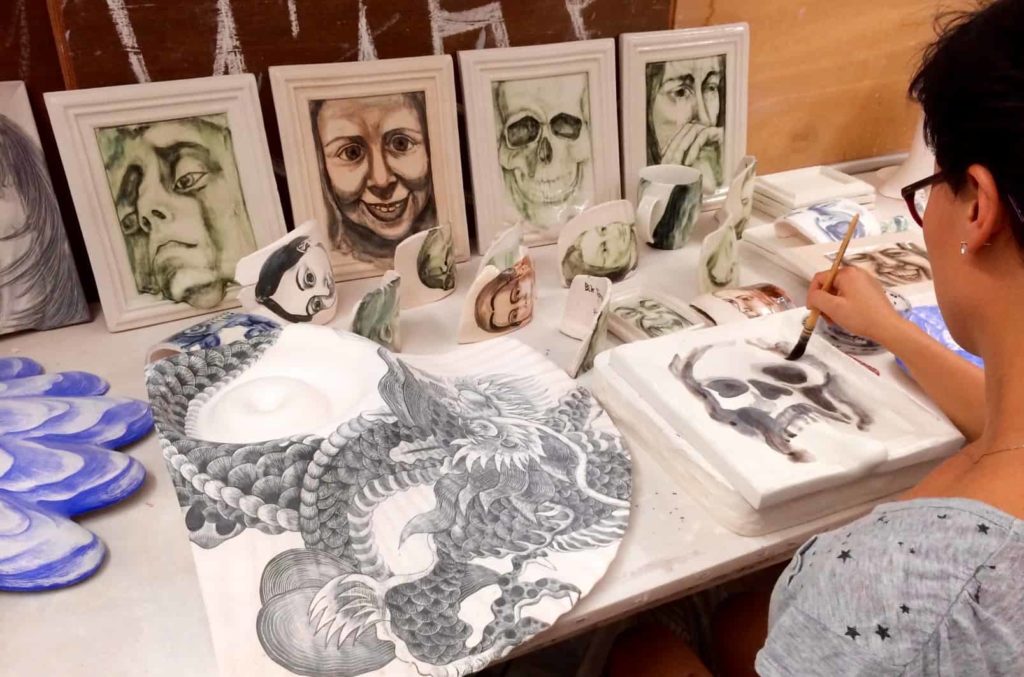
Myungjin Kim received her MFA at Seoul National University in 2002. Since her arrival in the States over a decade ago she has taught ceramics for the University of Georgia in Georgia and also at their campus in Cortona, Italy where she is currently on the faculty. She has additionally worked in our studios and taught for us at California State University, Long Beach.
Kim has participated in over fifty curated and juried exhibitions in the United States, Europe and Asia. Her ceramic art is in many prominent private collections around the United States. She is the artist in this group of four that has the broadest artistic range.
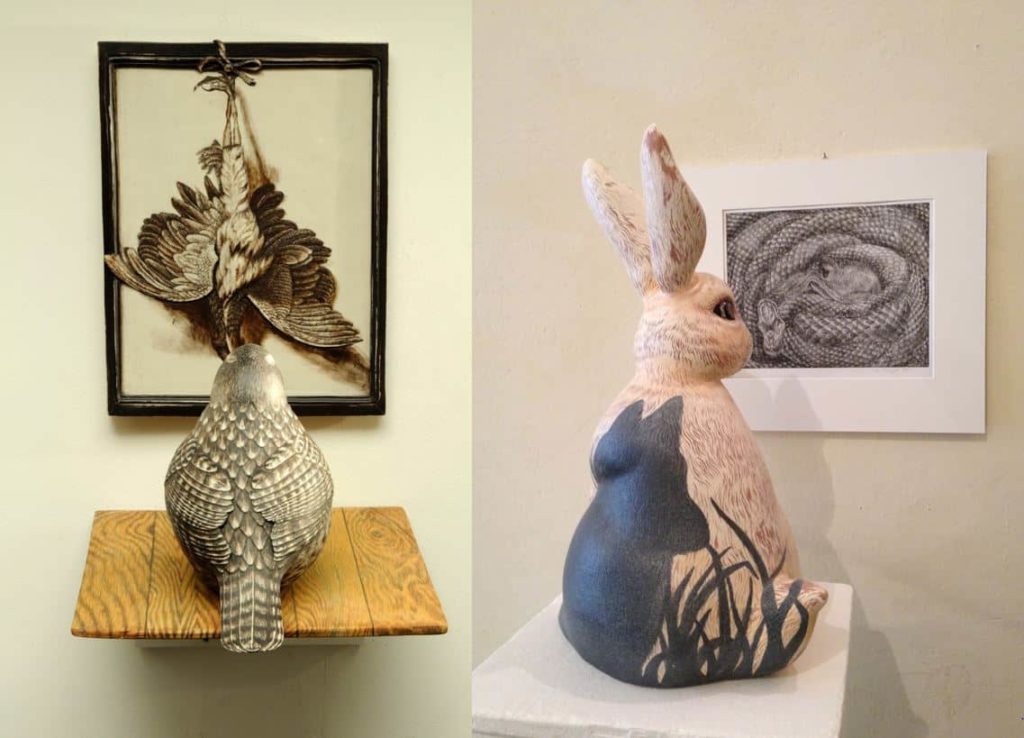
Quoting the artist from translated writing: ‘I am at the same time fascinated and gratified that when I work with clay I can paint, draw and sculpt on many different levels In the same work if I chose. There are times when the work is very Korean inspired and times when the work transcends a specific culture framework and its subject matter is simply human.’
In a sense, Kim is a story teller who in the same body of work will create tableaus that direct one’s attention to the dreamy innocence of a young child’s imaginary world, or make a poignant autobiographical work about the separation from her homeland Korea.
I think that Kim’s interest in creating the illusion of one kind of space while creating the physical reality of another has been one of the primary strengths in her art. She finds it more complex and layered to frequently use an assortment of animals to stand in for humans in her work. It allows her to access a different level and quality of empathy, tenderness, irony or humour.
 She is an articulate maker whose sculpture is frequently an intersection of subject matters and objects from both nature and culture. She says ‘I travel as often as possible and I am inspired by the art of other cultures, in particular these days still life paintings from northern Europe. I enjoy their sometimes crisp sometimes dreamy level of realism and try to learn from them about the powerful artistic use of symbolism and narrative to tell parts of the story of human life.’
She is an articulate maker whose sculpture is frequently an intersection of subject matters and objects from both nature and culture. She says ‘I travel as often as possible and I am inspired by the art of other cultures, in particular these days still life paintings from northern Europe. I enjoy their sometimes crisp sometimes dreamy level of realism and try to learn from them about the powerful artistic use of symbolism and narrative to tell parts of the story of human life.’
The artist says she made these two porcelain jars to acknowledge the things in life that are not attainable. It is a fairly masterful command of three entirely different surreal renditions of space that have been made oddly believable.
This is the artist’s most current work. She is painting empathetic portraits on porcelain picture frames, inspired by images across culture and time. Collectively they represent a broad range of expression from joyous to horrified. Each of the candles has melted to different postures, suggesting the slippage of time or loss.. The portraits gazes back at the viewer through the field of candles. At the heart of the project is the idea that although each of us is human, we are quite capable of experiencing the smallest of events, like the burning of a candle with the widest variety of reaction.
Hwa Jin Lee
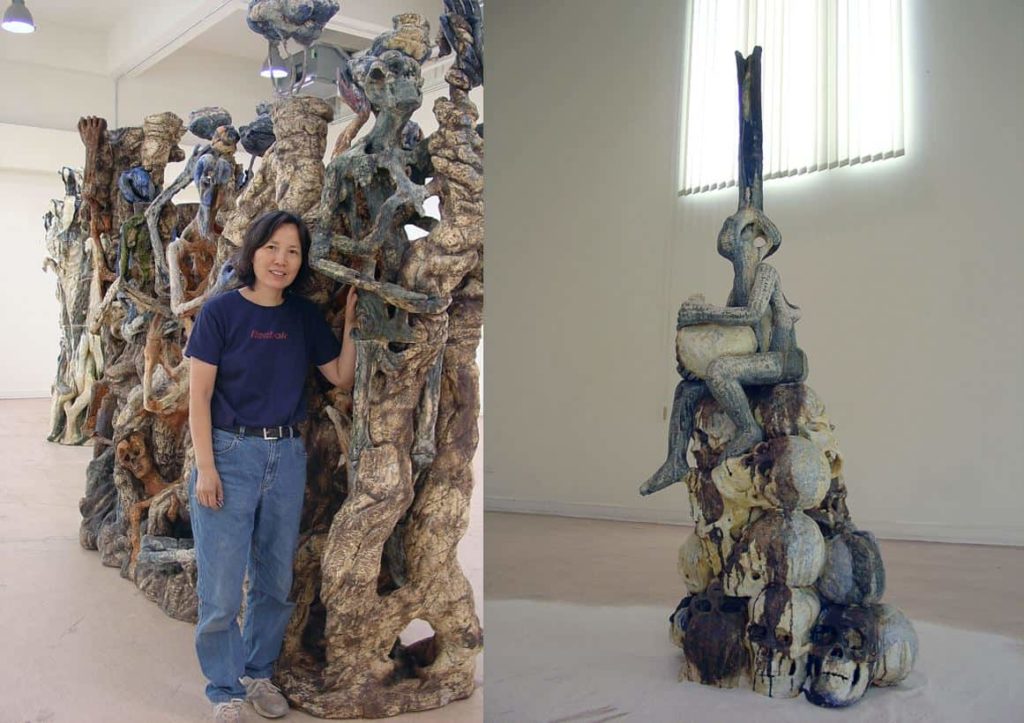
Hwa Jin Lee arrived in Long Beach in 1998 as a painter by the recommendation of Yuh Sunkoo and with very little previous experience in working with clay began to make ceramic sculpture that was astonishing to everyone. She was invited into the MFA at Long Beach and graduated in 2004.
I don’t think that I have ever witnessed an artist work as consistently hard as Hwa Jin. Her art is sincere and personal. There appeared to be no strategy to parlay her art into a professional career as a gallery artist; to my knowledge she never sold a work of art. This is one the works in her MFA graduation exhibition. Hwa Jin is shy and was reluctant to ask anyone for help in making or moving her work although most of what she created was very large. She wanted to be able to handle each section on her own and so devised wonderful strategies to create this work. This side of the sculpture is made up of dozens of modular hollow tubed structures that stack one on top of another like an enormous puzzle. A person as tall as me was able to enter the green glazed arch entrance in the middle as you see and stand up straight and walk through the work. It is certainly a puzzle and also stacks like the letters of a secret alphabet. I helped her install this work and to this day have no memory of any diagram or the schematic for how all of the parts were to go together, it was all in her head.
This is the reverse side of the same sculpture and you can see that the passage winds all the way through. What might not be obvious to you is that this is the middle section of an enormous heart, one of several that she made.
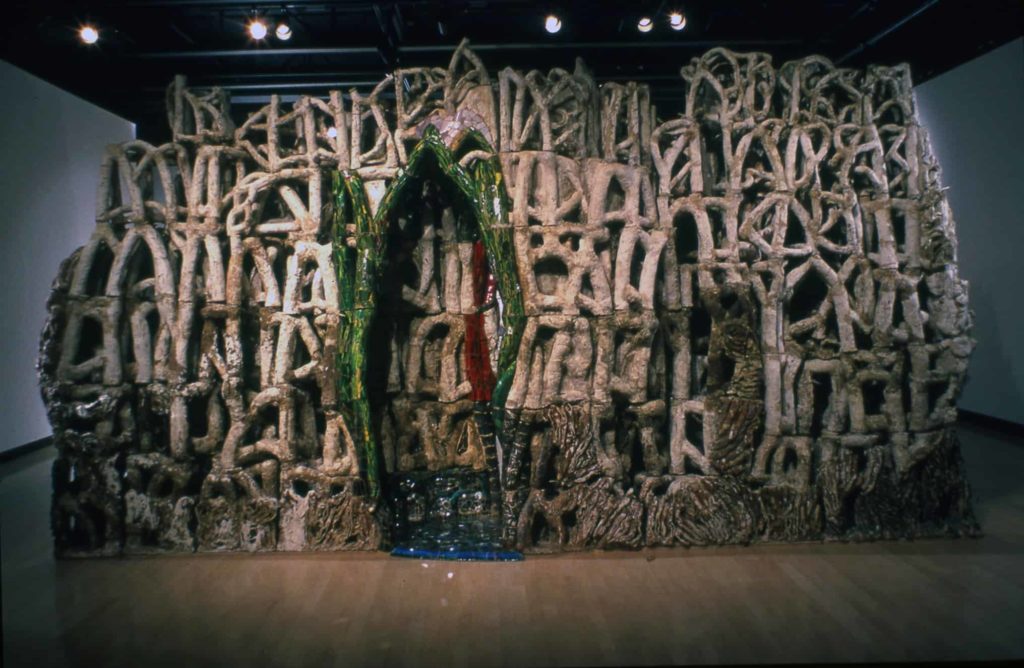
Sometimes language flows in her work like a river, mysterious and confounding. Scribed like tattoos across many of the surfaces of her figurative sculpture are words in assorted languages, random text, signs, punctuation, glyphs, pictographs and scribbles. Hwa-Jin is very shy but speaks three languages and I can assure you, would prefer to use none of them. They have come to her through displacement and absolute necessity, not academic pursuit or curiosity. This displacement of language and culture throughout her life has instinctively driven her to the safe haven of a vivid internal life and expression through art. It is the way that she is able to reach out and share her vision.
Her work is mysterious and speaks to a complex humanity not easily understood. Much of the figurative sculpture that she frequently made is not identifiable in particular by age, race, gender or social status, certainly a thought provoking art when all of those identifiers so crucial to how we understand and judge one another are eliminated. The work is a great equalizer and oddly perhaps against appearance here, yearns for a wholeness in humanity. Hwa-Jin is an artist’s artist, she currently works in her sister’s dry cleaning business and privately continues to make art that I hear is wonderful. Perhaps a little like a Korean shaman she divines into a world we cannot see and this is her report back.
Each of the Korean artists that I have shared with you is complex, not easily satisfied and driven to create. They have each had to work through what it means to leave the embrace of a homeland and navigate the complexities of making a life in the arts in the US. I am personally thankful that each of them found their way to Long Beach and shared important time in their artistic growth. If I had more time I would share the next five remarkable Korean artists that have been through Long Beach and then another five after that, there have been so many.
Author
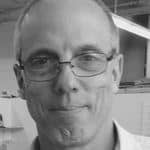 Tony Marsh lives and works in Long Beach California. He has been on the faculty at California State University Long Beach for 27 years and is devoted to both higher education and his art practice.
Tony Marsh lives and works in Long Beach California. He has been on the faculty at California State University Long Beach for 27 years and is devoted to both higher education and his art practice.

